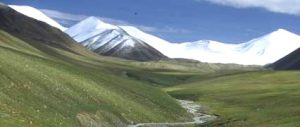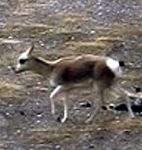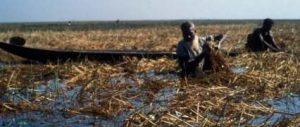A number of biodiversity “hotspots” are located on the Tibetan Plateau. With their highly distinctive species, ecological processes and evolutionary phenomena, these areas are some of the most important areas on earth for conserving biodiversity. The Tibetan Plateau is one of the most ecologically diverse landscapes on earth. It includes the most intact example of mountain rangelands in Asia with a relatively intact vertebrate fauna, and is one of the largest remaining terrestrial wilderness regions left in the world. The area is home to numerous rare and endangered wildlife species such as the wild yak, Tibetan wild ass, or kiang, the migratory Tibetan antelope, or chiru, Tibetan argali and snow leopard. Conserving these animals and their habitat is an important priority for the global conservation community.
George Schaller, the renowned field biologist who has spent decades working to conserve the wildlife of the Tibetan Plateau and adjoining Himalayan regions, wrote of the vast rangelands of the northern Tibetan landscape, “The beauty of these steppes and peaks will persist, but without wildlife they will be empty and the Tibetans will have lost part of their natural and cultural heritage. To bequeath the Chang Tang [the Tibetan word for the extensive steppes of the northern Tibetan Plateau] far into the next millennium will require a never-ending moral vigilance, a passion to understand the ecology, and a deep commitment to a harmonious coexistence between the nomads with their livestock and the wildlife. Without such dedication there will ultimately be a desert where only howling winds break a deadly silence.”
Schaller’s exhortation for heightened devotion to conserving the Tibetan ecosystem should be taken as a wake-up call for everyone interested in Tibet.
The Tibetan antelope, perhaps more than any other animal, embodies the expanse of the Chang Tang ecosystem. The chiru is a migratory animal and needs a vast landscape in which to travel between its winter ranges and birthing grounds. They cover distances of up to 400 kilometres, across the steppes and over mountains on their seasonal migrations. In 1994, I attempted to follow the chiru’s migration across the Chang Tang, to their birthing grounds on the northern edge of the plateau. Observing herds of hundreds of female chiru, with their female young of the previous year, travelling on ancient paths as they have for thousands of years is to bear witness to one of the earth’s outstanding ecological spectacles. Understanding chiru migratory movements could provide valuable insight into the structure and function of the Tibetan Plateau ecosystem and assist in efforts to protect biodiversity.
The continuation of Tibetan antelope migration, one of the last great natural marvels on earth, depends on better protection of the species, improved understanding of their ecology and better insights into the dynamics of the Tibetan Plateau ecosystem. It also requires innovative approaches to conservation and pastoral development that adopt participatory, integrated ecosystem management models that work at the landscape level.
If the antelope embodies the expanse, the wild yak characterises the elemental wild nature of the Chang Tang. I made a number of excursions to the Tibetan Plateau to conduct research on wild yaks. Standing almost two metres high at the shoulders, weighing up to a tonne and with horns a metre long, wild yaks are magnificent creatures. The wild yak is an indicator species; its presence reveals a special place – a sacred space. With wild yaks roaming the landscape, an ecosystem is still intact. If the land can provide habitat for wild yaks, many of the other species of Tibetan wildlife will be there as well.
The wild animal most commonly seen by travelers today in Tibet is the kiang. Galloping across the steppes, their russet and cream-colored bodies contrasting with the golden hue of the grasslands, kiang suggest a sense of unbridled freedom. The remote, northwestern part of the Tibetan Plateau offer notable examples of rangeland ecosystems relatively unchanged by humans and provide the untrammelled space for large herds of kiang to still run wild across the steppes. Wildlife conservation efforts have succeeded in protecting kiang, and their numbers have increased in many areas to the point where nomads now complain that large herds compete with their livestock for grazing.
As a rangeland ecologist, grasses and the interactions between vegetation and the animals – both wild and domestic – interest me. In my numerous journeys on the Tibetan Plateau I have endeavored to understand the ecology of the rangelands. Why are distinctive plant communities found in certain areas? What species of plants dominate these plant communities? What grasses are grazed by livestock? Do wild ungulates eat the same plants? Why are wildlife found in certain locations and not in others? Is there really competition for forage between kiang and livestock? These are questions I asked myself as I walked across the landscape, my eyes trying to pick out patterns on the ground. To the untrained eye that is unable to distinguish one plant from another, Tibetan rangelands, especially in the vast northern steppes, can appear boring and lifeless, particularly when majestic mountains dominate the horizon. But it is the diversity in plant species and mix of plant communities on the rangelands that influences the grazing patterns of livestock and the behaviour of wildlife. And it is this remarkable variation in vegetation on the steppe and the ecological dynamics of the Tibetan Plateau ecosystem that needs to be understood in order to sustain the natural resources for future generations.
Daniel J Miller is a rangeland ecologist and agricultural development specialist with over 15 years professional experience in agricultural development, natural resource management and biodiversity conservation in Asia. He has worked in Bhutan, China, Mongolia, Nepal and Pakistan and has traveled widely throughout South and South-east Asia. He speaks Nepalese, Tibetan and some Chinese.
The views and opinions expressed in this article are those of the author and may not necessarily reflect those of the US Agency for International Development or the US Government.
Homepage photo by Daniel J Miller



